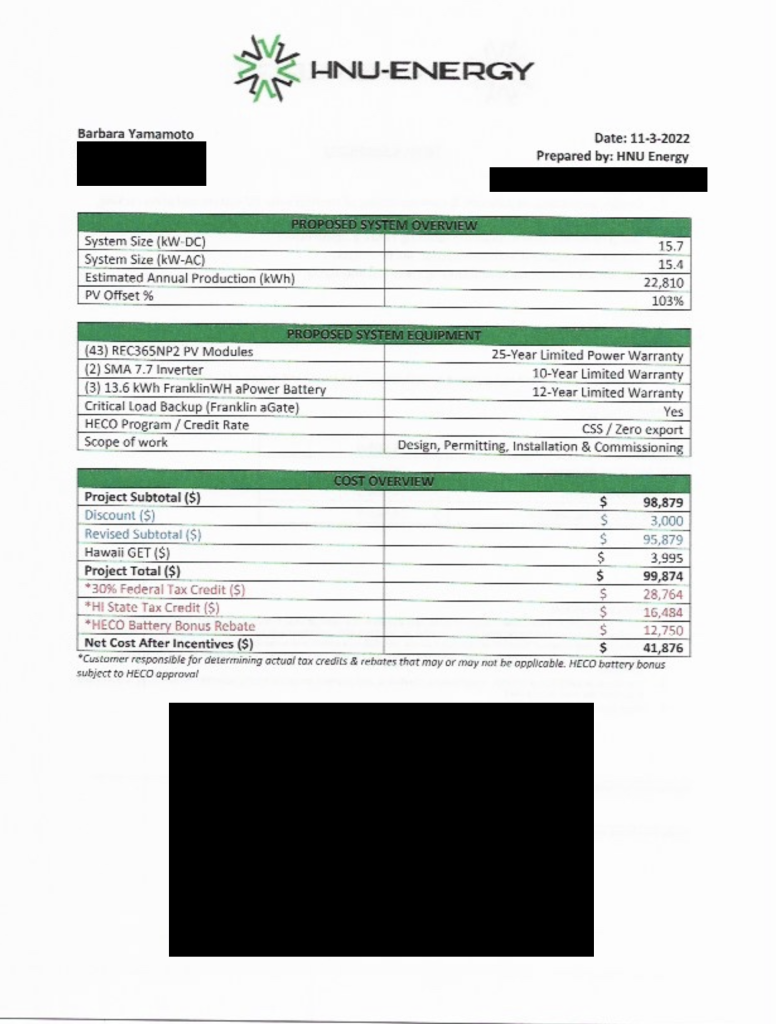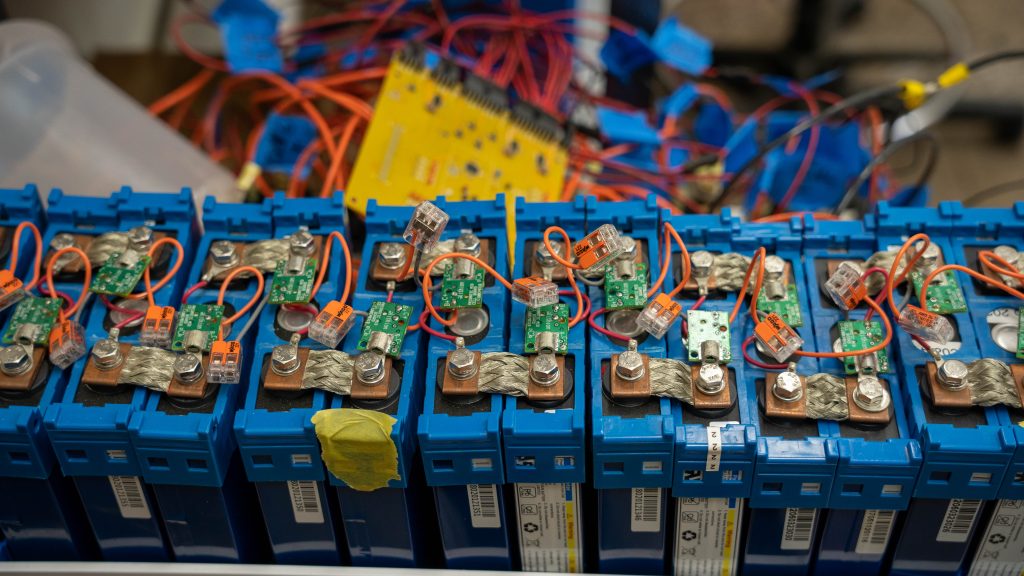HiVE’s buzzing: Future of solar battery storage for homes is made on Maui

HNU Energy CEO and super-geek Daniel “Dan” O’Connell has been helping Mauians install PV solar systems for nearly two decades, and in his spare time he has worked to develop his own battery that’s proving it’s worth in a worldwide search for energy storage solutions.
O’Connell envisioned “a tank to store your electricity” akin to “new homes that get a water tank to store hot water.” That was 17 years ago, before there were any batteries to power on-grid homes in Hawaiʻi.
Today, his HiVE Home Energy Storage Stackables outperform the latest Tesla Powerwall in capacity and round-trip efficiency, while also being less expensive for consumers and offering a longer warranty.
They come in various sizes that are optimized for home use, starting with the $10,000 “shortstack,” which can hold 15.35 kilowatt-hours (kWh) of energy. Customers can stack the components from midstack (30.7kWh) to tallstack (41kWh) to meet different energy needs.
Some local homeowners have latched on.
That includes Krista Garcia-Yamamura, who’s erecting a homestead on her and her husband’s off-grid farm in Haʻikū. The ag building, which she expects to have a commercial refrigerator and basic amenities, will run 100% on solar energy that’s stored in a HiVE Gen II Battery.
“I realize there are other batteries that are popular or whatever, but this battery is so unique and unique to Hawaiʻi,” said Garcia-Yamamura. “It gives us hope that this is such a better system.”
She calls O’Connell and HNU Energy President Michael Reiley “insanely brilliant solution creators.”
When her construction project was delayed due to concrete taking priority in Lahaina and shortage of concrete workers, O’Connell began working on a temporary solution to power her tiny home in a matter of days. She said HNU Energy is taking care of the permitting, paperwork and installation for the PV solar and storage system that’s still in progress.
“The fact that they do it all in one… there’s a lot of security in that, especially for a build where there’s so many moving pieces,” said Garcia-Yamamura.
HNU Energy has also installed LG, Franklin, Tesla and many other batteries over the years, at times when they felt those were the best available solutions for its customers.
Upper Kula resident Capt. Michael Lilly, a former Attorney General of Hawaiʻi, says his neighborhood frequently endures outages, or blackouts. His gas-powered generator could charge his phone and run his refrigerator, but it wasn’t sufficient to power his entire home. He is also located within the Public Safety Power Shutoff (PSPS) zone, areas where Hawaiian Electric may shut off power if they determine there is a high risk in wind forecasts and dry spells.
Lilly decided to call HNU Energy, which helped install a Franklin Home Battery and bring him “a miracle”: During outages now, he says his home isn’t affected.
“We’ve had three blackouts in the last three weeks, and in each case I had power and didn’t realize there was a blackout until I got an alert from Spectrum,” said Lilly.
Rather than an outage, he could see on the Franklin app that the whole house was running on his 5kWh battery. And, his solar panels still worked, which wasn’t the case before he had a battery.
Cost-wise, Lilly received the federal and state credit to cover 65% of the cost of the battery. Although they’re not cheap, he expects the cost will balance out over time.
Another battery user, Nāpili resident and business owner Barbara “Barbie” Yamamoto, saw her electric bill reduce from between $400-$900 to the $60-$150 range since installing PV solar panels and a Franklin Home Battery system. She’s receiving less energy from the grid.
In July 2023, HNU Energy installed her 43 solar panels and three Franklin Batteries while transitioning the HiVE from Gen I to Gen II, using “the best alternative product.”
Her total rebate was $57,998, for a net cost of $41,876 after incentives and tax credits for the solar project. Her batteries are set to a 20% threshold, which means she gets to keep a 20% charge at all times, as long as there’s sun charging her battery, she said.
After the Aug. 8, 2023 wildfire, the company also jerry-rigged Yamamoto a “HiVE Wagon,” a portable generator run off of two propane tanks and their proprietary battery, which she could use to power a Starlink and take to West Maui beaches.

**Note: Barbara Yamamoto started to work in sales for HNU Energy after her home’s solar installation. She is currently employed there part-time.
HiVE Gen II rolls out
O’Connell does a little bit of everything in his company’s modest 20,000 square-foot warehouse in Kahului, from photonics to medical devices. Working on the HiVE Gen II Battery is nothing out of the ordinary.
Its namesake is a call to the battery’s stackable components mimicking that of a beekeeper’s multi-story storage supers (hence “HiVE”), and the logo portrays that there is no “i” in HNU Energy.
But what sets the HiVE Gen II apart, says O’Connell, is its battery management system, which he has been optimizing for home-use for 17 years.
Lithium iron phosphate batteries — the primary chemistry of the HiVE’s cells —can last 20-plus years, if managed properly, according to HNU Energy. The key is to balance the electronics and lower the rate at which the battery is charged and discharged, known as the “C Rate.”
Where it counts, the HiVE’s batteries are larger than Tesla’s, so there’s “a bigger pot to store energy” to support a longer lifespan, explained Reiley, whose off-grid home in Kēōkea will run on a HiVE Battery.
But in overall unit size, the HiVE Gen II is smaller than the Powerwall 3 — Tesla’s latest model — and doesn’t need to be mounted to the wall. It sits on the ground about the size of a dishwasher and fits more storage into its frame than its well-known competitors. For example, the tallstack HiVE has the capacity equivalent to three Franklin or Tesla batteries, according to HNU Energy.
HiVE Energy Storage does most of its integration on Maui, while its components including the cells, come from available vendors such as those in China, South Korea, and Pennsylvania, said O’Connell.
The company, with 57 employees, has built HiVE batteries for assisted living facilities like Roselani Place, businesses like VIP Food Service and the Hyatt Regency Maui Resort, the UH Maui College and its carport, and even has a contract to build a HiVE battery for Joint Base Pearl Harbor-Hickam to power a F-35 maintenance hangar.
While they do several commercial projects, O’Connell says the HiVE Gen II Battery has always been intended for residents. They just need to scale it.
Riding on the ‘solarcoaster’
The forecast was mostly blue skies and sunny for rooftop solar in Maui County from 2001 to 2015.
A way to offset the cost of installation by sending excess energy back to the utility during the day, Hawaiian Electric’s (HECO) Net Energy Metering saw more than 60,000 homeowners statewide adopt solar panels. Then, nine years ago, HECO stopped accepting new net metering customers.
The utility replaced it with programs that necessitated a storage battery for the first time. It was a way to lighten the load on an overburdened grid, albeit simultaneously shake up what had been one of the fastest-growing rooftop solar markets in the country.
Some solar installers have downsized on Maui — including Sunrun closing its Kahului office, an employee told Maui Now — but O’Connell and HNU Energy had already prepared for what would come next in the constantly-changing market known as the ‘solarcoaster.’
Years before net metering ended, HiVE Energy Storage, the subsidiary of HNU Energy that manufactures batteries, had put a 22kWh Gen I HiVE Battery for home-use on the market, beating Tesla to the chase.
Amidst the chaos of rule changes, Jonathan Latimer, a Kīhei resident with solar panels, was riding high as he watched as his “electric bill dropped from 450 bucks to $18.”
He didn’t think it could get any better, until the Battery Bonus program allowed him to purchase a Gen I HiVE battery while remaining grandfathered in the net metering program. Now, he says his savings have increased even more.

“My battery system’s been operational for about two months now, and my last electric bill was negative 129 bucks,” said Latimer. “So all things considered, I’m pretty happy with that.”
It’s unlikely all Maui residents get to see those savings, with more corkscrews on the solarcoaster changing the incentives again, this year. HECO’s Battery Bonus program, which reached its cap on applicants, is now replaced by the new Bring Your Own Device (BYOD) program.
Some critics argue BYOD provides less compensation. O’Connell says he believes the changes and higher electric costs are due to “the utility trying to recover while they’re losing revenue.”
But O’Connell maintains that the new programs can still be beneficial to homeowners if their system is designed to take advantage of the benefits. In essence, that means generating solar PV and maximizing the monetary value of that energy by using a battery with a programmable control and timed discharging of energy.
To lower Hawaiʻi’s energy costs, which are the highest on average in the country, “everyone should have solar and a battery,” he said. “That’s our goal — to install HiVE for everyone on Maui, Hawaiʻi and the US.”
To learn more about HiVE Stackable Batteries, visit https://hnuenergy.com/batteries/ or contact the company at powerup@hiveenergysystems.com.



























